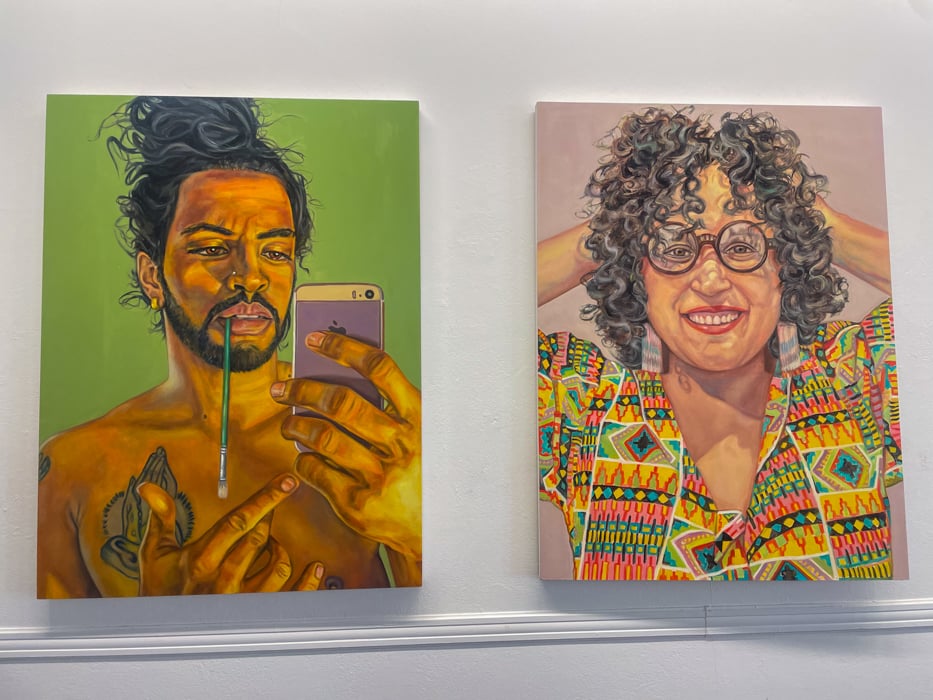 Dillon: Portrait of the Artist as a Young Man (left) and Tamara Torres (right) by Grace Graupe-Pillard.
Dillon: Portrait of the Artist as a Young Man (left) and Tamara Torres (right) by Grace Graupe-Pillard.
In Grace Graupe-Pillard’s painting Tamara Torres, a woman with a mop of gray, curly hair stares directly at the viewer through large, round glasses. Her warm eyes beckon. She wears a colorful, geometric blouse—yellow, turquoise, and red. It’s printed with concentric diamonds and arrayed triangles. The woman’s friendly disposition seems to continue in the textile.
The painting is part of LOOK BOOK: Attitude is Everything, a new show at The Gallery Upstairs at the Institute Library which brings together pieces from almost two dozen artists to examine how personal identity is expressed through fashion. Curated by Martha Lewis and Maxim Schmidt, the exhibition runs March 14 to May 25. It includes work from established artists solicited by Lewis and Schmidt alongside pieces submitted to the show’s open call.
There is an opening reception on March 21 from 6 p.m. to 8 p.m., which will feature a reading from Poet Laureate of Connecticut Antoinette Brim Bell. In conjunction with the show, the Institute Library will also host a conversation on “Fashion & Fascism” on April 25 from 6 p.m. to 8 p.m, as well as a “shoe-based puppet show” on May 22 to celebrate the show’s closing.
Lewis drew inspiration for the show from her love of look books—catalogs featuring samples of a particular designer’s or brand’s current work—which she first encountered as a young child.
“We used to do a lot of home sewing—we didn’t have a lot of money—and we’d go to the sewing store and there would be these enormous books from the pattern companies,” Lewis said. “I would spend hours going through them.”
She said she wanted the show to evoke the collage-like, often encyclopedic, feeling of these books.
Beyond this childhood memory, Lewis also was influenced by Catherine F. McKinley’s The African Lookbook, a photographic survey of pan-African women’s fashion across the 20th century. She was interested in the ways that the women pictured in the book expressed their agency and humanity through clothing.
“Women are makers, not bearers, of meaning,” Lewis said, paraphrasing the film theorist Laura Mulvey, whose work she found herself thinking about while reading The African Lookbook.
Lewis explained that her initial intention was to make the show specifically about women’s fashion for women’s history month. But as she and Schmidt began collecting works, they thought they would expand the purview of the exhibition to be more broadly about how people use clothes to tell stories.
“The show is all about fashion but it’s also about self-identity, and how you want to be seen—and not particularly about haute couture,” Lewis said.
“A homemade aesthetic is a big part of this,” she added. “These are not store-bought looks, these are us.”
Such sensibility is captured in Lys Guillorn’s humorous piece Changing Room. The work—a pink knitted swatch with rainbow fringe at the bottom—looks to be the beginning of a scarf. Guillorn’s knitting needles remain at the top of the piece, and, in contrasting black stitching, the swatch reads “I’M STILL TRYING THINGS ON.”
Alan Neider’s textile collages offer a similar, if less explicit, interpretation of fashion as a process rather than a product. In his piece Yellow Bag, fabrics are pleated, bunched, crumpled, and sewn together in a mass on the wall. Among the fabric assemblage are necklaces, winding fabric ropes, and the titular bag. The sculpture evokes a growing pile of laundry, the scrap bin of a seamstress, or a swirling crowd of people with varying styles.
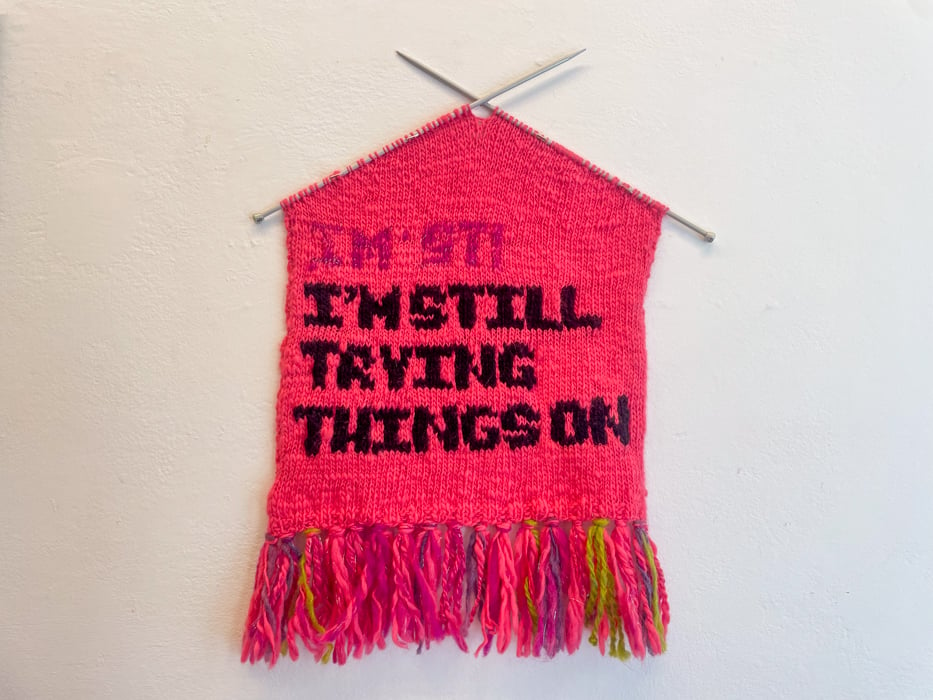
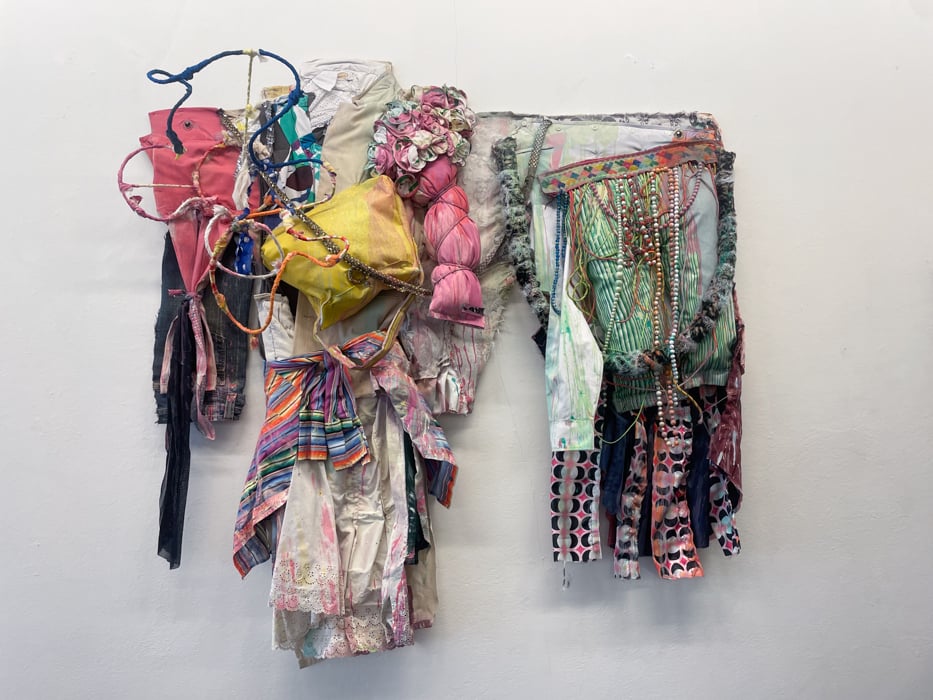 Top: Changing Room by Lys Guillorn. Bottom: Yellow Bag by Alan Neider.
Top: Changing Room by Lys Guillorn. Bottom: Yellow Bag by Alan Neider.
Across the room, Scott Schuldt and Cecilia Bitz’s precisely beaded anorak contrasts Neider’s gestural work. The piece, entitled The Explorations of Professor Bitz, is a collaboration between Schuldt, a bead artist, and Bitz, a climate scientist at the University of Washington who studies arctic sea ice. Schuldt and Bitz originally made the piece in 2011 for the annual convention of the American Meteorological Society.
The anorak—modeled after what the first successful arctic explorers wore, itself modeled off traditional Inuit garments—is made of a cream-colored canvas and sewn to the exact specifications of Bitz. Appliqued on top of the coat are beadwork renderings of elements important to arctic climate science.
A map of the arctic wraps around the shoulders and greenhouse gas molecules adorn the hood. The body of the garment features equations which describe glacial motion and conservation of energy, and the cuffs are encircled with graphs of the Keeling Curve and average global temperature.
Flames rise up from the bottom hem of the anorak, carefully rendered in red, orange, and yellow beads. On top of the fiery background, Schuldt sewed the stock ticker symbols for major oil and coal producers: XOM (Exxon Mobil), COS (Canadian Oil Sands), BTU (Peabody Energy).
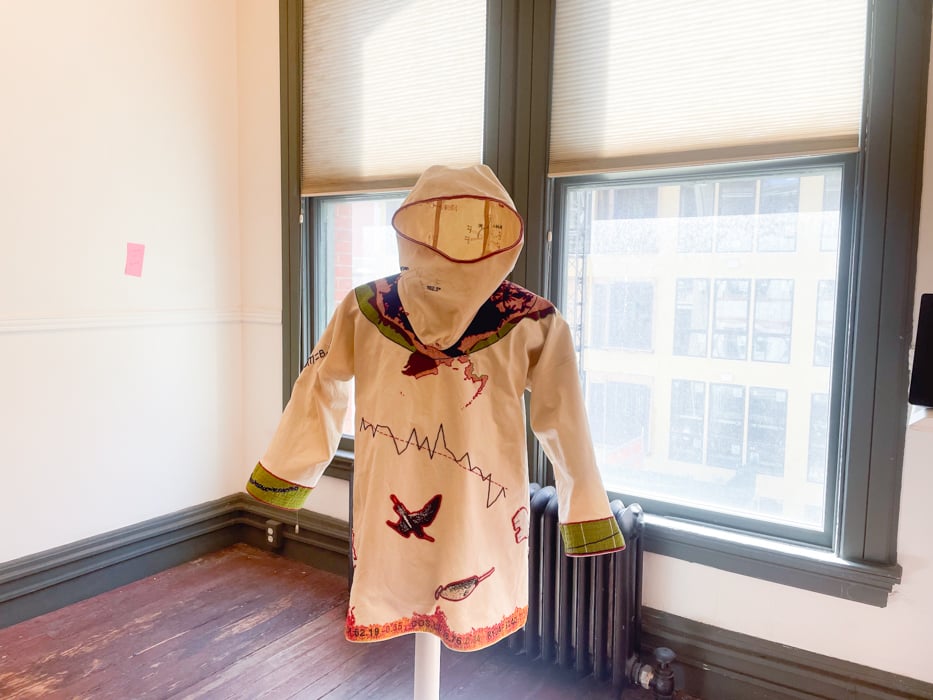
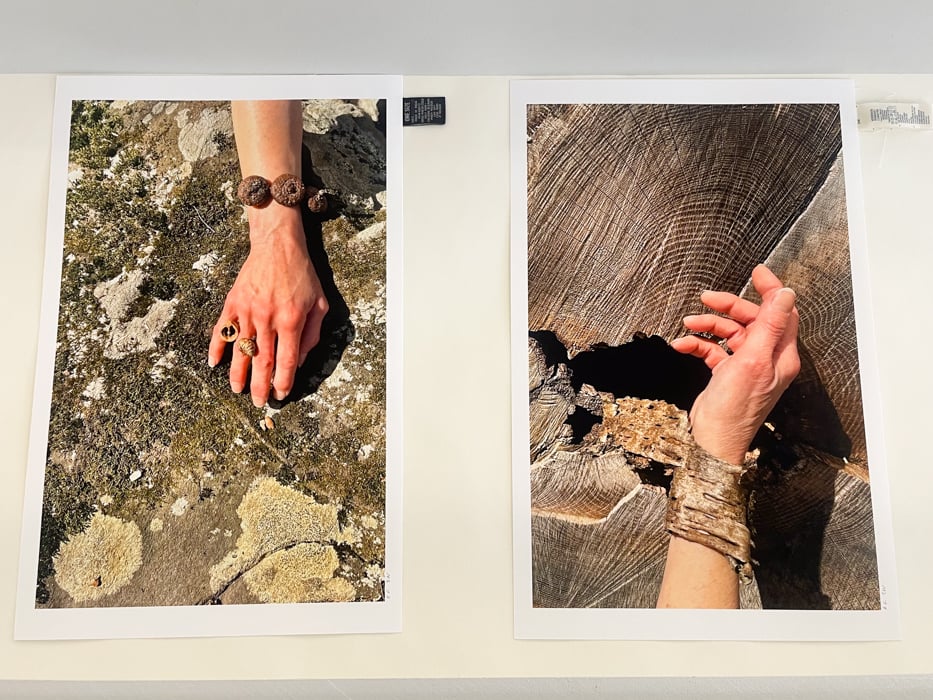 Top: The Explorations of Professor Bitz by Scott Schuldt and Cecilia Bitz. Bottom: hand on rock with lichen (left) and hand wrapped in birch bark with oak tree rings (right) by Kathryn Frund.
Top: The Explorations of Professor Bitz by Scott Schuldt and Cecilia Bitz. Bottom: hand on rock with lichen (left) and hand wrapped in birch bark with oak tree rings (right) by Kathryn Frund.
The climatic themes in Schuldt’s anorak continue in a pair of photographs by Kathryn Frund. The pictures are self-portraits of artist’s hands atop tree stumps. In one image, the truncated tree is hard and smooth, its grain swirling beneath Freund’s fingers; in the other, it’s covered in a soft bed of yellow and green moss. She wears bracelets on her wrist fashioned from the tree’s bark.
“I’m glad that climate emerged as one of the themes of the show,” Lewis said. “Fast fashion is so harmful, and the pieces we have provide an interesting contrast to that.”